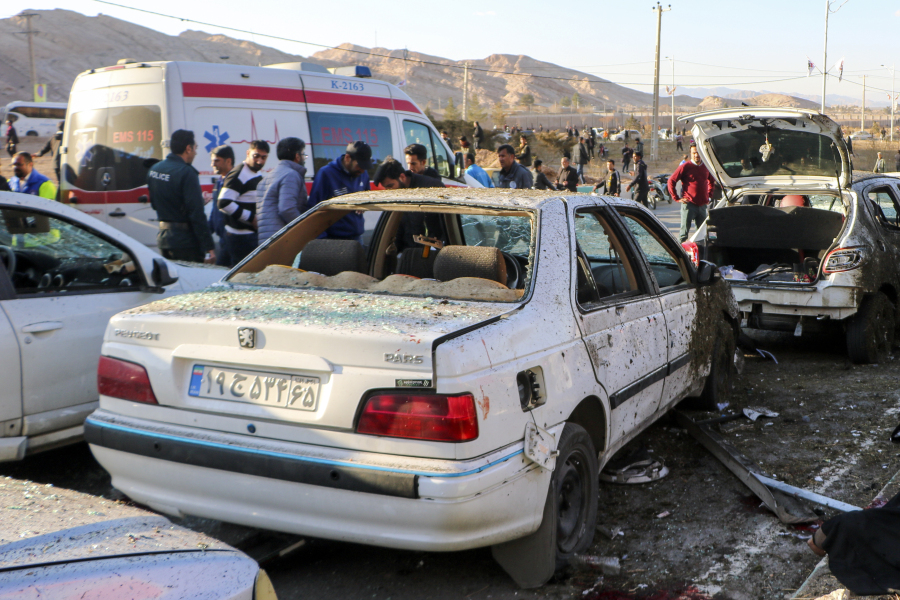DUBAI, United Arab Emirates (AP) — Two bombs exploded Wednesday at a commemoration for a prominent Iranian general slain in a U.S. drone strike in 2020, Iranian officials said, killing at least 103 people as the Middle East remains on edge over Israel’s war on Hamas in the Gaza Strip.
No one immediately claimed responsibility for what appeared to be the deadliest militant attack to target Iran since its 1979 Islamic Revolution. At least 211 people were wounded.
The blasts minutes apart shook the city of Kerman, about 820 kilometers (510 miles) southeast of the capital, Tehran, and sprayed shrapnel into a screaming crowd fleeing the first explosion.
The gathering marked the fourth anniversary of the killing of Gen. Qassem Soleimani, the head of the Revolutionary Guard’s elite Quds Force, in a U.S. drone strike in Iraq. The explosions occurred near his grave site as long lines of people gathered for the event.
Iranian state television and officials described the attacks as bombings, without immediately giving clear details of what happened.
The first bomb was detonated around 3 p.m., and the other went off some 20 minutes later, the Iranian interior minister, Ahmad Vahidi, told state television. He said the second blast killed and wounded the most people.
Images and video shared on social media appeared to correspond with the accounts of officials, who said the first blast happened about 700 meters (765 yards) from Soleimani’s grave in the Kerman Martyrs Cemetery near a parking lot. The crowd then rushed west along Shohada Street, where the second blast struck about 1 kilometer (0.62 miles) from the grave.
A delayed second explosion is often used by militants to inflict more casualties by targeting emergency personnel responding to an attack.
Iranian state TV and state-run IRNA news agency quoted emergency officials for the casualty figures, which rose rapidly in the hours after the explosions. Authorities declared Thursday would be a national day of mourning.
Iran has multiple foes who could be behind the assault, including exile groups, militant organizations and state actors.
While Israel has carried out attacks in Iran over its nuclear program, it has conducted targeted assassinations, not mass casualty bombings. Sunni extremist groups including the Islamic State group have conducted large-scale attacks in the past that killed civilians in Shiite-majority Iran, though not in relatively peaceful Kerman.
Iran also has seen mass protests in recent years, including those over the death of 22-year-old Mahsa Amini in 2022. The country also has been targeted by exile groups in attacks dating back to the turmoil surrounding its 1979 Islamic Revolution.
Iran itself has been arming militant groups over the decades, including Hamas, the Lebanese Shiite militia Hezbollah and Yemen’s Houthi rebels. As Israel wages its devastating war in Gaza after Hamas’ Oct. 7 attacks that killed 1,200 people in Israel and saw over 200 others taken hostage, both Hezbollah and the Houthis have launched attacks targeting Israel that they say come on behalf of the Palestinians.
Israel is suspected of launching an attack Tuesday that killed a deputy head of Hamas in Beirut, but that attack caused limited casualties in a densely populated neighborhood of the Lebanese capital. Last week, a suspected Israeli strike killed a Revolutionary Guard commander in Syria.
A Houthi spokesman, Mohammed Abdel-Salam, sought to link the bombings to Iran’s “support for the resistance forces in Palestine and Lebanon,” though he did not specifically blame anyone for the attack.
In Beirut, Hezbollah leader Hassan Nasrallah called the people who died in the attacks “martyrs who died on the same road, cause and battle that was led by” Soleimani.
Russian President Vladimir Putin called the attack “shocking in its cruelty and cynicism,” while Turkish President Recep Tayyip Erdogan condemned the “heinous terrorist attacks.”
Neighboring Iraq expressed condolences, and the European Union issued a statement offering “its solidarity with the Iranian people.”
Iranian President Ebrahim Raisi was expected to speak Wednesday evening.
Soleimani was the architect of Iran’s regional military activities and is hailed as a national icon among supporters of Iran’s theocracy. He also helped secure Syrian President Bashar Assad’s government after the 2011 Arab Spring protests against him turned into a civil, and later a regional, war that still rages today.
Relatively unknown in Iran until the 2003 U.S. invasion of Iraq, Soleimani’s popularity and mystique grew after American officials called for his killing over his help arming militants with penetrating roadside bombs that killed and maimed U.S. troops.
A decade and a half later, Soleimani had become Iran’s most recognizable battlefield commander. He ignored calls to enter politics but grew as powerful, if not moreso, than its civilian leadership.
Ultimately, a drone strike launched by the Trump administration killed the general, part of escalating incidents that followed America’s 2018 unilateral withdrawal from Tehran’s nuclear deal with world powers.
Soleimani’s death has drawn large processions in the past. At his funeral in 2020, a stampede broke out in Kerman and at least 56 people were killed and more than 200 were injured as thousands thronged the procession. Otherwise, Kerman largely has been untouched in the recent unrest and attacks that have struck Iran. The city and province of the same name sits in Iran’s central desert plateau.
Until Wednesday, the deadliest attack to strike Iran since the revolution was the 1981 truck bombing of the Islamic Republican Party’s headquarters in Tehran. That attack killed at least 72 people, including the party’s leader, four government ministers, eight deputy ministers and 23 parliament members.
In 1978 just ahead of the revolution, an intentionally set fire at the Cinema Rex in Abadan killed hundreds of people.



